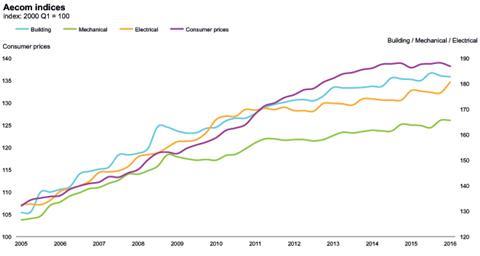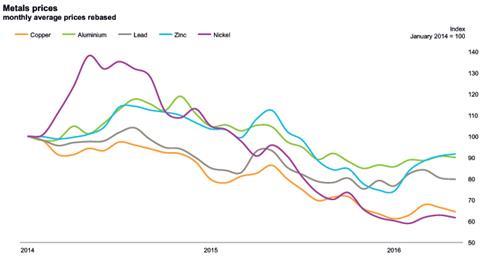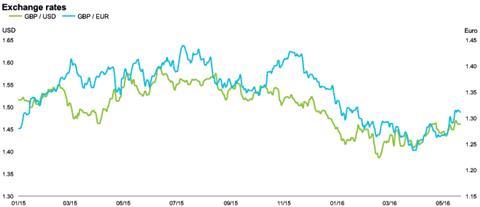Labour cost inflation remains the primary culprit for a continued rise to building costs, but the rate at which materials costs are growing is still moderate. Michael Hubbard of Aecom reports
01 / Key changes
| % | Direction | |
|---|---|---|
| Building cost index | +0.6 | ▲ |
| Mechanical cost index | +1.1 | ▲ |
| Electrical cost index | +1.8 | ▲ |
| Consumer prices index | +0.2 | ▲ |
(Q1 2016 figures are provisional)
Building cost index
A composite measure of building costs increased over the last 12 months by 0.6% at Q1 2016. Labour costs continue to rise but materials cost inflation overall is much weaker.
Mechanical cost index
The rate of annual change increased to 1.1% at Q1 2016 from 1% in the preceding quarter. Labour cost inflation still accounts for most of the annual increase.
Electrical cost index
The electrical cost index increased by 1.8% over the year. This higher rate of annual change primarily results from a wage award in early 2016.
Consumer prices index
The consumer price inflation rate recorded continuing weak annual change at Q1 2016.
The following chart shows Aecom’s index series since 2005, reflecting cost movements in different sectors of the construction industry and consumer prices.

02 / Price adjustment formulae for construction contracts
Price Adjustment Formulae indices, compiled by the Building Cost Information Service (previously by the Department for Business Innovation & Skills), are designed for the calculation of increased costs on fluctuating or variation of price contracts. They provide guidance on cost changes in various trades and industry sectors – ie. those including labour, plant and materials – and on the differential movement of work sections in Spon’s price books.
The 60 building work categories recorded an average increase of 0.14% on a yearly basis. Higher increases were recorded in the following categories:
Price adjustment formulae
| May 2015 – May 2016 | % change |
|---|---|
| Finishes: flexible tiles and sheet coverings | 4.5 |
| Cladding and covering: plastics | 4 |
| Ironmongery | 3.3 |
| Finishes: plaster | 2.7 |
| Finishes: painting and decorating | 2.4 |
| Stonework | 2.3 |
| Glazing | 2.3 |
The largest price decreases include:
Price adjustment formulae
| May 2015 – May 2016 | % change |
|---|---|
| Cladding and covering: copper | -5.8 |
| Piling: steel | -5.3 |
| Windows and doors: aluminium | -5 |
| Concrete: reinforcement | -4.4 |
| Pipe and accessories: copper | -4.3 |
| Metal: decking | -4.0 |
| Fencing | -3.5 |
Materials
03 / Summary
- Consumer price inflation recorded negligible change in Q1 2016 versus the same time last year ▲
- Manufacturing input prices continue to fall, but the pace of declines slowed in Q1 2016 ▼
- Industry output prices remain negative on a yearly basis, although the annual rate of change moderated slightly in Q1 2016 ▼
- Commodity prices continue to post negative annual rates of change ▼
- Construction materials increased on a monthly basis to April but prices fell overall on an annual basis ▼
04 / Key Indicators
Construction industry
The All Work material price index fell by 1.6% in the year to April 2016, marking 17 consecutive monthly decreases on a yearly basis metric. Housing-related materials dropped by 0.7% over the last 12 months. Non-housing materials prices also fell over the year, declining by 2.1%. Mechanical and electrical services materials prices extended their slide too.
| Construction materials | % change April 2015 – April 2016 | |
|---|---|---|
| New housing | -0.7 | ▼ |
| Non-housing new work | -2.1 | ▼ |
| Repair and maintenance | -1.3 | ▼ |
| Mechanical services materials | ||
| Housing only | -1.0* | ▼ |
| Non-housing | -1.1* | ▼ |
| Electrical services materials | -2.1* | ▼ |
*provisional
| % change April 2015 – April 2016 | |
|---|---|
| Ironmongery | +11.3 |
| Insulating materials (thermal or acoustic) | +4.2 |
| Pre-cast concrete products: bricks, blocks, tiles and flagstones | +3.9 |
| Sanitaryware: plasticlly | +2.7 |
| Pre-cast concrete products: generally | +2.6 |
| Doors and windows | +2.4 |
| Bricks | -2.6 |
| Sawn / planed wood (imported and domestic) | -4.3 |
| Metal sanitaryware | -4.4 |
| Concrete reinforcing bars (steel) | -8 |
| Fabricated structural steel | -10 |
| Imported plywood | -14.9 |
Data sources: ONS and BIS
UK economy
| Consumer prices | % change April 2015 – April 2016 | |
|---|---|---|
| Consumer Prices Index (CPI) | 0.3 | ▲ |
Consumer price inflation rose by 0.3% in April. In his sixth letter to the chancellor, the Bank of England governor Mark Carney gave the following reasons for below-target inflation in the last year: “Sharp falls in commodity prices, the past appreciation of sterling, and to a lesser degree the subdued pace of domestic cost growth.” A benign outlook for inflation remains the generally accepted central scenario. However, the EU referendum and associated currency movements might affect inflation medium term.
| Industry input costs | % change April 2015 – April 2016 | |
|---|---|---|
| Materials and fuels purchased by manufacturing industry | -6.5 | ▼ |
| Materials and fuels purchased by manufacturing industry excluding food, beverages, tobacco and petroleum industries | -1.7 | ▼ |
Input prices declined by 6.5% on a yearly basis up to April 2016. While the longer trend has been overwhelmingly negative, recent data continues recent moves to smaller annual price declines. Monthly percentage changes have been positive through the latter part of Q1 2016. Fuel, crude oil and domestic food led the declines. Core input inflation, which excludes volatile items, also posted a smaller annual decline in April than previous months. Both measures are following a similar trend after some divergence in 2015.
| Industry output costs | % change April 2015 – April 2016 | |
|---|---|---|
| Output prices of manufactured products | -0.7 | ▼ |
| Output prices of manufactured products excluding food, beverages, tobacco and petroleum | 0.5 | ▲ |
Factory gate prices declined 0.7% on a yearly basis in April, marking 22 consecutive months where prices have fallen. The core index, which is narrower because it excludes items such as petroleum and food, increased by 0.5% in the year to April 2016.
Metal prices

| % change May 2015 – May 2016 | ||
|---|---|---|
| Aluminium | -13.8 | ▼ |
| Copper | -25.3 | ▼ |
| Lead | -14.4 | ▼ |
| Zinc | -18.3 | ▼ |
| Nickel | -35.7 | ▼ |
There is little sign of any significant change to the prolonged negative annual price trends for metal commodities. In theory, denominator effects may come into play such that the rate of negative yearly change slows. However, this may be offset by continuing weakness of demand-side factors, largely stemming from global macroeconomic conditions. Efforts to address over-capacity for metals commodities could provide some support to prices, as would a weaker US dollar.
Exchange rates

| May 2015 average | May 2016 average | % change | |
|---|---|---|---|
| GBP / EUR | 1.3829 | 1.2846 | -7.1 |
| GBP / USD | 1.5182 | 1.4518 | -6 |
GBP levelled out against the euro and US dollar in Q1 2016, although it regained some ground recently against its two major currency pairs. Some of this is attributable to an early poll lead for a Remain outcome in the EU referendum. But a recent reversal of this referendum polling saw sterling sell off once more. This highlights the FX volatility expected for the near-term period – which includes immediately after the referendum result too.
Labour
05 / Labour market statistics
- Average weekly earnings (total pay including bonuses) in construction fell to £599 in March 2016, from £606 a month earlier. Annually, total earnings increased 5.8% in March on a single-month basis, and 8.1% annually on a three-month average basis. Regular pay (excluding bonuses and arrears) increased to £582 per week, with annual rates of 6.2% on a single-month basis and 7.5% using a three-month average.
- Construction industry regular and total pay continues to exceed changes to average earnings for the whole economy classification, which were broadly 2% at March 2016.
- Real average weekly earnings for the whole economy increased by 1.3% (regular pay) in March.
06 / Wage agreements
Construction Industry Joint Council
To date the parties to the Construction Industry Joint Council (CIJC) have not agreed a pay deal, after recent talks stalled. The most recent CIJC pay offer of 2.5% in June 2016, 2.75% in June 2017 and an additional day’s holiday from January 2018 was rejected by Ucatt. It is now seeking a new deal on wages and wider reform of the CIJC agreement.
Joint Council Committee of the Heating, Ventilating and Domestic Engineering Industry
A 3.0% increase in hourly wage rates came into effect from 5 October 2015. The daily travel allowance also increased by 3% from 5 October 2015. Amendments to the basic working week also applied from 6 October 2014, as the number of hours per week reduced from 38 to 37.5.
The Joint Industry Board for the Electrical Contracting Industry
Members received a 2% pay rise in January 2015, followed by a 3% increase from January 2016.
Building and Allied Trades Joint Industry Council
The Building and Allied Trades Joint Industrial Council (BATJIC) agreed a two-year pay deal effective from 27 June 2016. Workers will receive a 2.5% pay rise this year and a further 2.5% increase in 2017. Lower paid operatives will get a bigger boost of 4% this year, followed by 2.5% next year. The agreement includes a commitment that, if inflation in early 2017 is higher than 2.5%, then the 2017 pay rise will match this up to a limit of 3%.
The Joint Industry Board for Plumbing, Mechanical Engineering Services in England and Wales
A 2.5% increase in hourly rates came into effect from 4 January 2016. Employees rates of pay, allowances entitlements and benefits are published in promulgation No. 171 of JIB for Plumbing, Mechanical Engineering Services in England and Wales agreement.
The BATJIC rates of wages effective from 27 June 2016 are:
| Standard rates of pay for 39 hours per week | Per week | Per hour |
|---|---|---|
| S/NVQ3: Advanced | £459.81 | £11.79 |
| S/NVQ2: Intermediate | £395.85 | £10.15 |
| Adult General Operative | £351.00 | £9.00 |
| For entrants aged 19 years and over | ||
| ” Third 12 months with NVQ2 | £374.01 | £9.59 |
| ” Third 12 months without NVQ | £325.65 | £8.35 |
| Apprentices under 19 years of age | ||
| ” 18 years of age with NVQ2 | £307.71 | £7.89 |
| ” 18 years of age without NVQ2 | £325.65 | £8.35 |
WAGE AGREEMENT SUMMARY
The following table summarises the wage agreements currently in force for the principal wage fixing bodies within the construction industry
| Operatives | Agreement body | Current basic hourly rate | Effective since | Details in | Date of next review |
|---|---|---|---|---|---|
| Builders and civil engineering operatives | Construction Industry Joint Council | Craft rate: £11.33 / hour | 29 June 2015 | Spon’s Architects’ and Builders’ Price Book 2016 | June 2016 |
| Building and Allied Trades Joint Industrial Council (BATJIC) | S/NVQ3 Advanced Craft: £11.79 / hour | 27 June 2016 | Spon’s Architects’ and Builders’ Price Book 2017 | June 2017 | |
| Plumbers | The Joint Industry Board for Plumbing Mechanical Engineering Services in England and Wales | Advanced plumber: £14.41 / hour | 4 January 2016 | Spon’s Architects’ and Builders’ Price Book 2017 | 2 January 2017 |
| Scottish and Northern Ireland Joint Industry Board for the Plumbing Industry | Advanced plumber: £13.41 / hour | 6 July 2015 | Spon’s Architects’ and Builders’ Price Book 2017 | A two-year agreement: Year 1 2015 = 2.5% Year 2 2016 = 2.0% | |
| H&V operatives | Joint Conciliation Committee of the Heating, Ventilating and Domestic Engineering Industry | Craftsman: £12.20 / hour | 5 October 2015 | Joint Conciliation Committee of the Heating, Ventilating and Domestic Engineering Industry | 5 October 2016 |
| Electricians (national) | The Joint Industry Board for the Electrical Contracting Industry | Approved electrician: £15.61 / hour (own transport) | 4 January 2016 | JIB for the Electrical Contracting Industry | A two-year agreement: Year 1 2015 = 2% Year 2 2016 = 3% |
| Scottish Joint Industry Board for the Electrical Contracting Industry | Approved electrician: £15.61 / hour (own transport | 4 January 2016 | SJIB for the Electrical Contracting Industr | A two-year agreement: Year 1 2015 = 2% Year 2 2016 = 3% |
Guide to data
Aecom’s cost indices track movements in the input costs of construction work in various sectors, incorporating national wage agreements and changes in materials prices as measured by government index series.
They are intended to provide an underlying indication of price changes and differential movements in the various work sectors but do not reflect changes in market conditions affecting profit and overheads provisions, site wage rates, bonuses or materials’ price discounts/premiums. Market conditions and commentary are outlined in Aecom’s quarterly market forecast (last published May 2016).







No comments yet